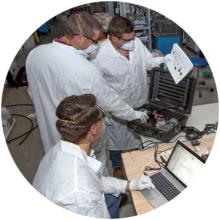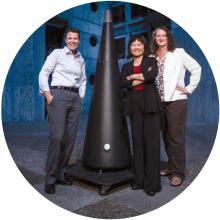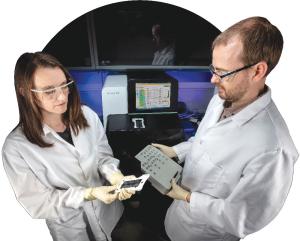In a year of exceptional challenges and upheaval, Lawrence Livermore National Laboratory had another exceptional year pushing the frontiers of science and technology to strengthen national security in a rapidly changing world.
With its principal mission to ensure nuclear deterrence, LLNL provides unique expertise and world-class scientific tools in support of the Department of Energy (DOE) and its National Nuclear Security Administration (NNSA). Through the nuclear stockpile annual assessment process, leadership in the life-extension of aging warheads, and continuous improvement in underlying scientific understanding of nuclear weapon phenomena, we contribute to the safety, security, and effectiveness of the U.S. nuclear deterrent and the reduction of nuclear threats around the world. The special scientific and engineering tools and competencies we rely on to carry out this mission enable us to broadly contribute to the nation’s security through technological innovation.
Emerging Security Challenges
The Laboratory is charged with looking ahead to identify and explore emerging science and technology, especially aspects that might impact national security. For example, early in the 2010s, LLNL focused research and development efforts on advanced manufacturing, foreseeing applications within NNSA. Today this forward-looking work is helping enable success in stockpile modernization efforts. Similarly, in the 1990s, building on the discovery of chromosome sorting methods at LLNL, bioscientists developed DNA-based diagnostic techniques for pathogen detection to address potential biosecurity threats. As a result, Livermore was in a position to contribute unique insight into the anthrax attacks in the early 2000s. Most recently, diagnostic techniques commercialized by LLNL were among the first to be adapted and authorized for SARS-CoV-2 testing.
This annual report highlights more of our contributions to the national pandemic response effort. By early February, LLNL researchers released a preliminary set of 3D protein structures for the virus and, later, an initial set of antibody sequences aimed at binding and neutralizing SARS-CoV-2. In addition, Laboratory engineers developed, prototyped, and commercialized within months a novel device capable of supplementing the nation’s limited stockpile of ventilators without further straining the constrained supply chain for components.
Stockpile Modernization
In our primary mission area, the Laboratory is responsible for designing and certifying the nuclear explosive package for both the W80-4 warhead, to be carried on the all-new Long-Range Standoff missile, and the W87-1, for Minuteman-3 and the new Ground Based Strategic Deterrent system. The W80-4 program is the first in the stockpile stewardship era in which a nuclear package is being life-extended for deployment on an all-new delivery system; the W87-1 is the first with the ambitious plan to fully remanufacture all components of the warhead.
To address these challenges, we are working closely with the NNSA production facilities and developing designs that exploit innovations in manufacturing methods. For example, we are piloting a new kind of partnership with Kansas City National Security Complex (KCNSC), to establish a production development enclave at LLNL. The enclave will enable weapon design and production personnel to work side-by-side to rapidly advance manufacturing capabilities and establish readily qualified processes for final production of parts at KCNSC. Once demonstrated, this model of design/production integration can be adapted to impact future modernization programs.
The Laboratory is using the unique power of Sierra, the world’s third fastest supercomputer, to perform high-fidelity 3D simulations of weapons performance and run large ensembles of simulations to quantify uncertainties in predictions. These efforts are directly impacting modernization programs and providing new insight into ongoing stockpile assessments. Beyond Sierra, we look forward to delivery in 2023 of El Capitan, NNSA’s first exascale supercomputer, which will enable qualitative increases in confidence for the future stockpile. Our flagship experimental facility, the National Ignition Facility, has provided critical validation of design options for the W80-4, while making measurable progress toward meeting the grand challenge goal of fusion ignition in the laboratory. Together, these exceptional capabilities allow us to confidently assess the safety, security, and reliability of the current and planned nuclear deterrent.
Broader Security Challenges
With our frontier science and technology, we provide unique expertise and capabilities to address threats across the spectrum of weapons of mass destruction and enable high-confidence implementation of arms control, nonproliferation, and other threat reduction measures. We contribute to deterrence broadly, as it intersects with emerging domains of competition and conflict, including space, cyberspace, and the “gray zone.” Similarly, we leverage these capabilities to develop solutions for energy and climate security and lend them to expand the endless frontier of basic scientific understanding, the foundation of innovation.
Working Through the Pandemic
In FY 2020, LLNL researchers met major milestones in all mission areas despite the COVID-19 pandemic. The health and safety of LLNL personnel has been paramount in managing the extent and pace of onsite activities. The Laboratory entered a state of safe standby in mid-March in response to the imposition of a statewide shelter-in-place order, and began returning personnel to work onsite a week later. Since early July, LLNL has been operating effectively in a posture of Normal Operations with Maximum Telework, with the daily onsite population averaging around one-third of full staff. A rapidly implemented telecommuting infrastructure enables those not onsite to work from home. Work on major onsite construction projects—described in this report and important to future mission success—remains on schedule and on budget.
The dedication and resilience of Laboratory employees, and the extraordinary effort of many mission-support organizations, explain why the Laboratory succeeded this year in the face of exceptional and continuing adversity. In particular, Health Services and LLNL’s biosafety team monitored employee health, developed guidelines and work-controls for onsite activities, and advised on pacing the growth of the onsite workforce. Information technology professionals quickly upgraded services to provide thousands of employees the ability to efficiently telecommute. Superhuman efforts also enabled LLNL to meet its aggressive hiring plans for FY 2020, and to enroll nearly 500 students to “virtually” work at the Laboratory last summer.
The Future
Outstanding people are the Laboratory’s most important resource. LLNL’s success is made possible by their excellence, and shared commitment to our values: new ideas, making a difference, integrity, inclusiveness, and loving the work. I have worked with many of them during my 36 years here, including nearly seven as Laboratory Director. In July, I announced that I will step down as director at the conclusion of the search for my successor. I look forward to welcoming the next director, confident LLNL’s unmatched tradition of excellence and record of service to the nation will continue








